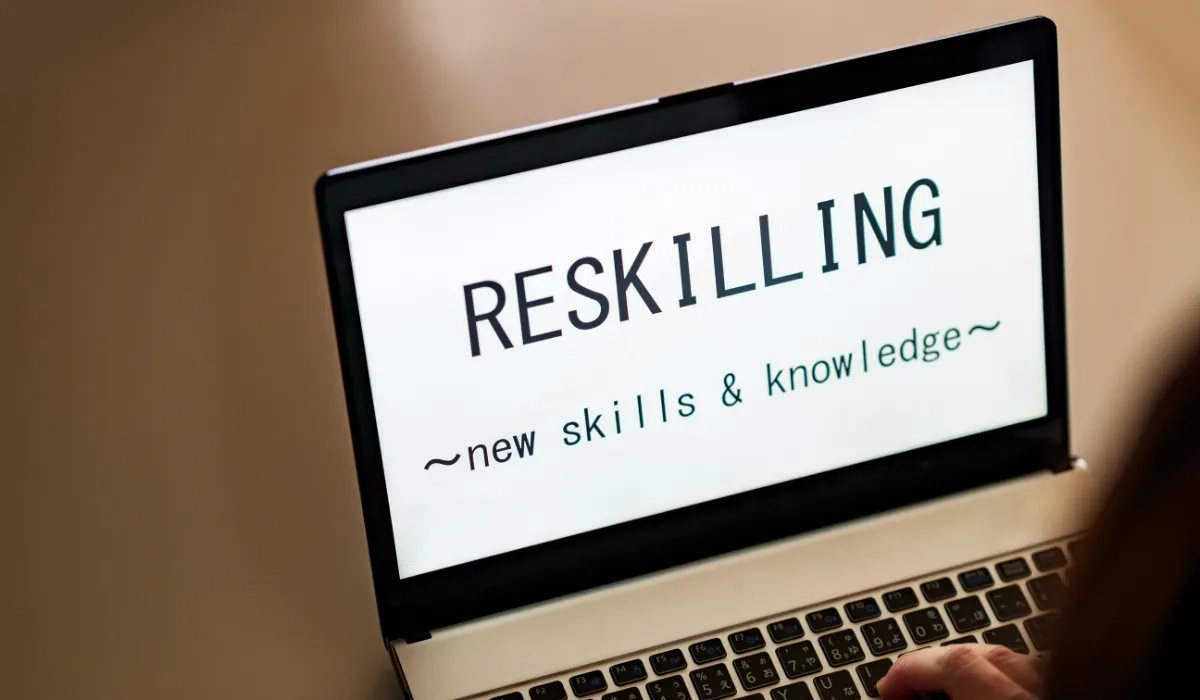JAKARTA, cssmayo.com – Reskilling: Adapting Workforces to Emerging Technologies has honestly been one wild ride in my career. When I first heard my company talking about “techno” changes and upskilling, I thought, “Hey, I’m good. I got this!” Spoiler: I did not have it. It turns out, learning new tech is less about being a genius and more about being super adaptable.
The rise of emerging technologies has revolutionized industries, reshaping the way we work and the skills required to thrive in the modern workforce. As automation, artificial intelligence (AI), and other innovations continue to transform job landscapes, companies and employees face a critical challenge: adapting to these changes to remain competitive. This is where reskilling comes in—a proactive approach to equipping workforces with the skills needed to embrace the future. In this article, we’ll explore the concept of reskilling, why it matters, and how it can help build future-savvy teams.
What Is Reskilling?

Reskilling refers to the process of learning new skills or gaining expertise in different areas to adapt to changing job requirements. Unlike upskilling, which focuses on enhancing existing skills, reskilling prepares individuals to transition into entirely new roles or industries.
Reskilling has become increasingly important in the age of technology, where automation and AI are replacing traditional jobs while creating new opportunities. For example, as self-driving technology reduces the need for truck drivers, workers can be reskilled to take on roles in logistics, fleet management, or AI system maintenance.
Key Characteristics of Reskilling
- Focus on Future Skills: Reskilling emphasizes learning skills that align with emerging technologies and industry trends.
- Adaptability: Reskilling helps workers adapt to new roles, industries, or technologies, ensuring they remain employable in changing job markets.
- Proactive Approach: Reskilling is often driven by employers, governments, or educational institutions to prepare workforces for future challenges.
- Lifelong Learning: Reskilling promotes continuous learning, encouraging individuals to stay updated on evolving skills throughout their careers.
Why Reskilling Matters
In today’s fast-paced, technology-driven world, reskilling is more than just a buzzword—it’s a necessity for businesses and individuals alike. Here’s why reskilling matters:
1. Addressing Automation’s Impact
Automation is reshaping industries, replacing repetitive and manual tasks with machines and algorithms. Reskilling helps workers transition into roles that require creativity, problem-solving, and technical expertise—skills that are less likely to be automated.
2. Bridging the Skills Gap
As new technologies emerge, the demand for specialized skills often outpaces supply. Reskilling helps bridge this gap by preparing workers to fill in-demand roles, such as data analysts, software developers, and cybersecurity experts.
3. Promoting Job Security
Reskilling empowers workers to stay relevant in the job market, reducing the risk of unemployment due to outdated skills. This is especially important in industries undergoing rapid technological change, such as manufacturing, healthcare, and finance.
4. Driving Business Growth
For businesses, reskilling is essential for maintaining a competitive edge. A future-ready workforce can adapt to new technologies, improve productivity, and drive innovation, ensuring the company’s success in evolving markets.
5. Fostering Inclusion
Reskilling initiatives can help marginalized groups access new opportunities, promoting diversity and inclusion in the workforce. For example, programs that teach coding or digital literacy can empower individuals from underserved communities to pursue careers in technology.
My Journey Into Reskilling
My personal journey with reskilling began during a major shift in my career. As a marketing professional, I realized that traditional advertising methods were being replaced by data-driven strategies powered by AI and machine learning. At first, I felt overwhelmed by the rapid pace of change, wondering how I could keep up.
That’s when I decided to embrace reskilling. I enrolled in online courses to learn about digital marketing, analytics, and AI tools. While the process was challenging, it was also incredibly rewarding. Not only did I gain new technical skills, but I also developed a deeper understanding of how technology is reshaping my industry.
Reskilling didn’t just help me stay relevant—it opened up new opportunities for growth and innovation. Today, I’m able to leverage AI-powered platforms to create personalized marketing campaigns, analyze customer data, and optimize results in ways I never thought possible.
How Reskilling Prepares Workforces for Emerging Technologies
Reskilling is a powerful tool for adapting to the challenges and opportunities of emerging technologies. Here are some ways it prepares workforces for the future:
1. Identifying Future-Ready Skills
Reskilling starts by identifying the skills that will be most in demand as technologies evolve. For example, as AI becomes more prevalent, skills like programming, data analysis, and ethical decision-making are becoming increasingly valuable.
2. Providing Accessible Learning Opportunities
Reskilling initiatives often leverage online courses, workshops, and certifications to make learning accessible to workers. Platforms like Coursera, LinkedIn Learning, and Udemy offer flexible options for acquiring new skills.
3. Encouraging Cross-Functional Expertise
Reskilling helps workers develop cross-functional expertise, enabling them to transition into roles that combine technical and soft skills. For example, a reskilled graphic designer might learn UX/UI design to work in tech-driven industries.
4. Building Resilience
Reskilling fosters resilience by preparing workers to navigate uncertainty and adapt to change. This is especially important in industries where technological disruption is accelerating.
5. Collaborating Across Sectors
Reskilling often involves collaboration between businesses, governments, and educational institutions to create programs that address workforce needs. For example, partnerships between tech companies and universities can offer specialized training in AI, cloud computing, or cybersecurity.
Practical Strategies for Reskilling
Reskilling requires a proactive approach from both employers and individuals. Here are some practical strategies to make reskilling successful:
For Employers
- Conduct Skills Assessments: Identify gaps in your workforce and determine which skills will be needed in the future.
- Offer Training Programs: Provide employees with access to workshops, certifications, and online courses.
- Encourage Career Mobility: Create pathways for employees to transition into new roles within the company.
- Leverage Technology: Use AI-driven tools to personalize learning experiences and track progress.
- Promote a Learning Culture: Foster an environment where continuous learning is valued and rewarded.
For Individuals
- Stay Informed: Keep up with industry trends and identify emerging skills.
- Invest in Learning: Enroll in courses, attend workshops, and pursue certifications.
- Build a Growth Mindset: Embrace change and view reskilling as an opportunity for personal growth.
- Network and Collaborate: Connect with professionals in your field to learn from their experiences.
- Seek Support: Take advantage of reskilling initiatives offered by employers, governments, or educational institutions.
Reskilling Success Stories
Reskilling has transformed countless careers and industries. Here are some inspiring examples:
- Manufacturing: Workers displaced by automation have been reskilled to operate and maintain advanced robotics systems.
- Healthcare: Nurses and technicians are being trained in telemedicine and digital health tools to meet the demands of modern healthcare.
- Technology: Non-technical employees have transitioned into tech roles by learning programming, data analysis, or cloud computing.
- Retail: Retail workers are being reskilled to manage e-commerce platforms and digital inventory systems.
Key Takeaways from Reskilling
Reskilling is more than just a response to technological change—it’s a transformative process that empowers workers and businesses to thrive in the future. Here are some key lessons:
- Adaptability Is Essential: Reskilling helps individuals and organizations stay agile in a rapidly changing world.
- Collaboration Drives Success: Reskilling requires partnerships between employers, governments, and educators.
- Learning Never Stops: In the age of technology, lifelong learning is the key to staying relevant.
- Opportunities Outweigh Challenges: While reskilling can be challenging, it opens up new opportunities for growth and innovation.
- Future-Ready Teams Are a Competitive Advantage: Businesses that invest in reskilling build resilient, future-savvy teams that drive success.
Conclusion
Reskilling is the key to navigating the challenges and opportunities of emerging technologies. By equipping workforces with future-ready skills, reskilling empowers individuals to thrive in changing job landscapes and helps businesses maintain a competitive edge.
For me, reskilling has been a transformative journey, teaching me the value of adaptability, curiosity, and lifelong learning. As we move forward, it’s essential to embrace reskilling as a proactive solution to the challenges of automation, ensuring that workers and businesses alike are prepared for the future.
By investing in reskilling, we can build a workforce that is not only resilient but also ready to harness the full potential of technology to drive innovation, inclusion, and growth.
Elevate Your Competence: Uncover Our Insights on Techno
Read Our Most Recent Article About Social Construction of Technology!




